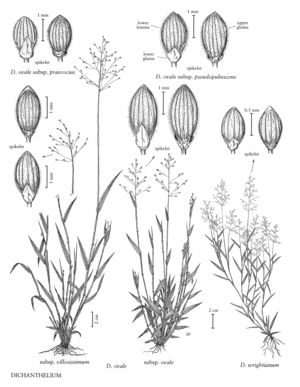Difference between revisions of "Dichanthelium ovale subsp. villosissimum"
FNA>Volume Importer |
FNA>Volume Importer |
||
| Line 21: | Line 21: | ||
-->{{Treatment/Body | -->{{Treatment/Body | ||
| − | |discussion=<p><i>Dichanthelium ovale </i>subsp.<i> villosissimum</i> grows in dry, sandy, open pine and oak woodlands. It and <i></i>subsp.<i> pseudopubescens</i> are the most common and widespread subspecies throughout the eastern United States. The range of <i></i>subsp.<i> villosissimum</i> extends to Mexico, Honduras, Guatemala, and Nicaragua. It grades into the less pubescent <i></i>subsp.<i> pseudopubescens</i>, and occasional specimens with smaller spikelets approach <i>D. acuminatum </i>subsp.<i> acuminatum</i>, which is usually densely grayish, velvety-pubescent.</p> | + | |discussion=<p><i>Dichanthelium ovale </i>subsp.<i> villosissimum</i> grows in dry, sandy, open pine and oak woodlands. It and <i></i></i>subsp.<i><i> pseudopubescens</i> are the most common and widespread subspecies throughout the eastern United States. The range of <i></i></i>subsp.<i><i> villosissimum</i> extends to Mexico, Honduras, Guatemala, and Nicaragua. It grades into the less pubescent <i></i></i>subsp.<i><i> pseudopubescens</i>, and occasional specimens with smaller spikelets approach <i>D. acuminatum </i>subsp.<i> acuminatum</i>, which is usually densely grayish, velvety-pubescent.</p> |
|tables= | |tables= | ||
|references= | |references= | ||
| Line 41: | Line 41: | ||
|publication year= | |publication year= | ||
|special status= | |special status= | ||
| − | |source xml=https://jpend@bitbucket.org/aafc-mbb/fna-data-curation.git/src/ | + | |source xml=https://jpend@bitbucket.org/aafc-mbb/fna-data-curation.git/src/f6b125a955440c0872999024f038d74684f65921/coarse_grained_fna_xml/V25/V25_1172.xml |
|subfamily=Poaceae subfam. Panicoideae | |subfamily=Poaceae subfam. Panicoideae | ||
|tribe=Poaceae tribe Paniceae | |tribe=Poaceae tribe Paniceae | ||
Revision as of 19:21, 24 September 2019
Basal blades 3-7 cm, evenly long pilose. Culms more than 1 mm thick, stiff, often decumbent or prostrate in the fall; internodes with soft, spreading or retrorse, papillose-based hairs, hairs longer than 4 mm. Cauline sheaths with soft, spreading or retrorse hairs, hairs longer than 4 mm, papillose-based; ligules 2-5 mm; blades 6-10 mm wide, both surfaces densely pilose, hairs longer than 4 mm, margins short-ciliate basally, scabridulous and faintly whitish elsewhere. Spikelets 2.1-2.5 mm, usually ellipsoid, with dense, spreading, papillose-based hairs. Lower glumes 1/3– 1/2 as long as the spikelets, usually acute. 2n = 18.
Discussion
Dichanthelium ovale subsp. villosissimum grows in dry, sandy, open pine and oak woodlands. It and subsp. pseudopubescens are the most common and widespread subspecies throughout the eastern United States. The range of subsp. villosissimum extends to Mexico, Honduras, Guatemala, and Nicaragua. It grades into the less pubescent subsp. pseudopubescens, and occasional specimens with smaller spikelets approach D. acuminatum subsp. acuminatum, which is usually densely grayish, velvety-pubescent.
Selected References
None.
